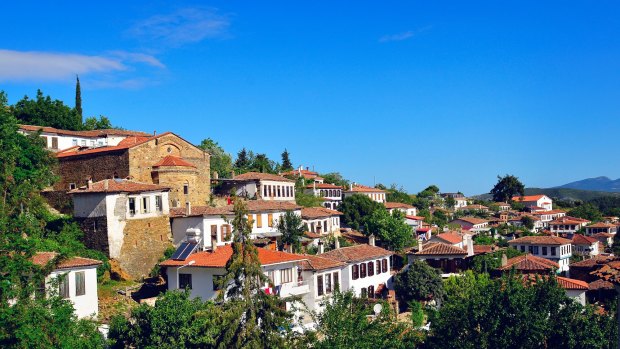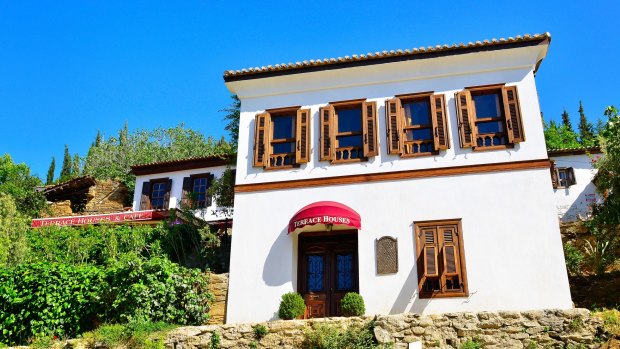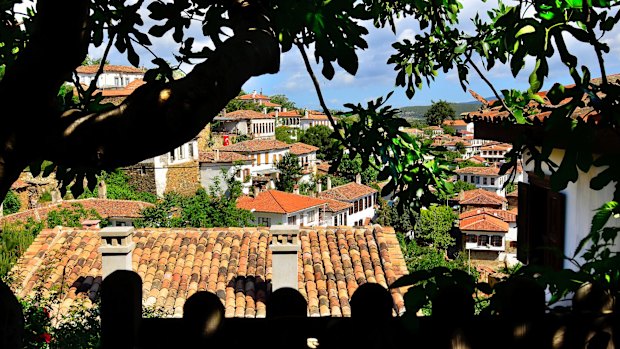This was published 9 years ago
Terrace Houses review, Sirince, Turkey: The fig tree bears fruit

All the Terrace Houses are located at the high end of the village. Credit: Michael Gebicki
The Terrace Houses, Sirince, Turkey. Can this possibly be the way? I'm at the upper end of the village of Sirince, just inland from Turkey's Aegean coast, hunting for my accommodation. There was a sign "Terrace Houses", back where the laneway kinked, just before I was forced to round a bend in my rental car with mirrors pulled in to avoid scraping the houses on either side. Now I'm in a tiny open triangle with a muddy tractor blocking the way.
"Look up," says Omer, my host, when I call. On top of the grassy rise above me is a man the colour of nutmeg, smiling and waving. Omer leads me up a steep staircase, through a creaking gate in a stone wall into a private garden, all my own for the next few days, and into the double-storey, whitewashed Fig House.
On the ground floor there's a well equipped kitchen and dining room and at the back, a big bathroom with a claw-foot bath and shower. Upstairs are two bedrooms, each with queen-size beds and plenty of wardrobe space.

The Terrace Houses in Sirince, Turkey.Credit: Michael Gebicki
The style is peasant chic, strong on textures but silky smooth. Along with the breakfast bar made from an old thresher, there are plush antique armchairs and couches, Persian rugs and a chandelier in one bedroom. The beds look like matrimonial affairs made as a wedding gift for a Sicilian godfather and sheets and pillowcases are crisp, white Turkish cotton.
In the rambling garden, along with the fig tree that gives the house its name, there's a spray of pretty pink roses by the front door, lavender bushes with droning bees, a peach tree and olive trees. Just below the house is a private sanctuary among the greenery with a table and chairs, higher up on the other side of the house is a terrace with sun lounges.
Omer and his English wife, Charlotte, have three other village houses, Olive, Grapevine and Heritage, each of them restored in the same style, with the same attention to detail. The largest of the quartet is Grapevine, which sits on the edge of the village, with room for six and its own pretty garden with apricot, pomegranate, fig and mandarin trees.

A view of Sirince from the terrace of the Fig House.Credit: Michael Gebicki
It's been a love story. Several years ago, while living in Istanbul, Omer and Charlotte drove through Sirince, gasped, saw the potential and bought the house that became Grapevine. At the time, it belonged to a local shepherd, who had been living in one of the upstairs rooms, above what was once the stables. The rest of the house was inhabited by swallows.
In what was to become a template for their renovation work, they spent 16 months restoring the house, installing electrics and plumbing including a solar hot-water system before they opened the door to paying guests. Fig House, a later acquisition, was even more of a wreck. The upper floors had collapsed, a tree grew from the back wall and the house was inhabited by a family of goats. The whole house had to be demolished before being reconstructed over two years in the same vernacular style, right down to the half-metre thick stone walls.
The transformation of the Terrace Houses parallels what has happened to Sirince itself. A rustic, remote agricultural village until a few years ago, Sirince has become a tourism hot spot. The reason is simple. If ever there was a nascent Cinderella lurking within muddy boots and smock, it's Sirince. Originally a Greek village, it was they who named it Cirkince, "ugly", in a bid to throw would-be pillagers and conquerors off the scent. The Greeks left in the aftermath of the Greco-Turkish War of 1919-22 and when Turkish residents moved in, they simply picked up where the Greeks left off. Apart from a new mosque little changed. Sirence's houses, shops, squares and even its Greek Orthodox churches went unmolested, protected by poverty and isolation.
Today, in an age with a taste for bucolic and rough hewn, Sirince's time has come. Set on a pine-covered hillside, overlooking vineyards and olive groves, Sirince's whitewashed walls, ochre tiled roofs and knitted alleyways are an irresistible attraction. Wandering through the town takes you along a procession of flagstone lanes and into tiny squares with grapevines and oleanders creeping up the sides of the houses. Miraculously, it's a totally unified townscape, free from the concrete-box horrors that blight much of southern Turkey,
Sirince has embraced tourism with gusto. From June to early September, the parking lot at the entry to the village is packed with tour buses. By 10am the town is jammed with visitors who clog the twisting main road through the village, which is lined with shops selling hats, white cotton clothing, lacework, jewellery, artefacts and leather goods.
As a living, functioning historic remnant, Sirince provides a counterbalance to Ephesus, the big tourist attraction in these parts, just a 20-minute drive from Sirince. Founded by Greeks in the 10th century BC, Ephesus grew to become the seat of power for the Roman Empire in the eastern Mediterranean. This is now the region's major archaeological site, its amphitheatres, library, temples and grand processional boulevards standing in eloquent testimony to a rich and sophisticated city that numbered close to half a million at its peak in the 1st century AD. Close to Ephesus is the House of the Virgin Mary, reputedly where St John lived with Mary, mother of Christ, until her death.
In its drift from its rustic roots, Sirince has inevitably lost something.
Over breakfast on the terrace - olives, cheese, tomatoes, cucumbers, tea, coffee, eggs to order and proper marmalade - Charlotte tells me there used be half a dozen donkeys here, now there are two, although they're noisy fellows, given to braying at unsociable hours.
All the Terrace Houses are located at the high end of the village, and although your legs might object, it's a blessing. The shops end lower down, and only a few intrepid visitors make the climb up the narrow laneway to where the houses are located. "Once they see the muddy tractor, they usually turn around," Omer says. "I only hope the farmer never moves it."
The writer was a guest of Emirates and stayed at Fig House at his own expense.
TRIP NOTES
MORE INFORMATION
GETTING THERE
The closest airport is Izmir Adnan Menderes, 90 kilometres away, from where there are direct flights to Istanbul, less than an hour away. Hire cars are available from the airport, and a hire car is essential.
STAYING THERE
The daily rate starts from $220 for two per night, or $1160 per week, including breakfast.
Sign up for the Traveller Deals newsletter
Get exclusive travel deals delivered straight to your inbox. Sign up now.